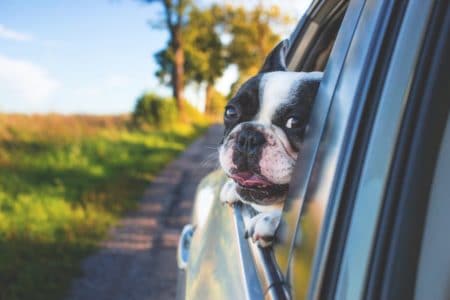
Has your dog been in a collision? Whether your dog is accompanying you on a cross-country road trip, or you are simply chauffeuring him to a vet appointment, keep in mind that the ever-present risk of a collision effects both canine and human passengers. Here are some important safety reminders when you are traveling with your dog.
Unrestrained Dogs Can Become Projectiles
The force of a collision will send any loose objects in the vehicle flying, including unrestrained dogs. This is dangerous not only for the dog, but also for any other people in the vehicle who might be struck by a canine cannon-ball careening through the vehicle. It is for this reason that properly restraining and securing your dog is crucial. There are a variety of harness devices available that connect to the vehicle’s seat belt, many of which do a good job of keeping dogs in place during a collision. Crating your dog during car trips is another good idea, as long as you strap down or otherwise secure the crate itself.
Dogs and Airbags
You wouldn’t want to let your dog ride in the front seat for the same reason you don’t let a small child ride in front — if the airbag is deployed, it can cause death or significant injury, regardless of whether or not they are restrained. Smaller dogs are particularly vulnerable.
Dogs Riding on the Driver’s Lap
This is a particularly dangerous way to ride with your dog in the car. A dog on a lap is subject to injury if the airbag deploys and it is impossible to use a proper restraint system while your dog is sitting on top of you, meaning your dog will become a projectile in a collision. Additionally, this greatly increases driver distraction, making the possibility of a crash much more likely.
Dogs in Truck Beds
There are numerous hazards associated with dogs riding in the back of a truck whilst exposed to the open air (this applies to dogs hanging out of car windows as well), including debris entering their eyes, nostrils, or mouth. Temperature and weather conditions are also a concern. Common sense dictates that under no circumstances is it ever acceptable for a dog to ride in the bed of a truck unrestrained. Even if your dog is so well behaved that you know they won’t jump out of the truck, there would be nothing to stop them from being thrown from the truck in the event of a collision, or even a bump in the road.
When Your Dog Has Been in a Collision
After an auto collision, your dog may be in a state of shock. It will be frightened and possibly injured. A dog’s first instinct will be to run and hide. It will not understand that you are trying to help and may become aggressive, even to people it knows. Despite the difficulty, it is important that you restrain your dog and put a dog muzzle on it so it can be safely taken to a veterinarian. Even a gentle dog, if frightened, can take a bite out of your arm and injured dogs may bite first responders and rescue workers.
In an emergency, a muzzle can be made from a piece of gauze, a necktie or even a sock. With one end of the cloth in each hand, lay it across your dog’s nose, as close to the eyes as possible. Wrap the cloth completely around the nose and tie firmly beneath the jaw. Pull the ends back on each side of your dog’s neck and make a tie behind the neck. Once your dog is secured, check to see if it is breathing normally and control any bleeding it may have. Transport your dog to the veterinarian immediately. Try to remain calm!
Injuries and Vet Bills
If your dog is injured in a collision and requires veterinary attention, there is a chance that your auto insurance will cover some portion of it under your property damage claim so check your policy.
Dogs in motor vehicle crashes can suffer a range of injuries, just like humans. The severity of injuries can vary depending on factors such as the speed of the crash, the size and breed of the dog, whether they were properly restrained, and the type of impact.
Common injuries dogs may sustain in crashes may include:
- Trauma: Dogs can experience trauma from the impact itself, such as blunt force trauma or being thrown against hard surfaces within the vehicle.
- Fractures: Broken bones are not uncommon in car accidents for both humans and dogs. Legs, ribs, and skulls are particularly vulnerable.
- Internal injuries: Dogs may suffer internal injuries such as organ damage, internal bleeding, or collapsed lungs due to the force of the impact.
- Head and spinal injuries: Trauma to the head or spine can result in serious injuries, including concussions, brain damage, or paralysis.
- Soft tissue injuries: Sprains, strains, and other soft tissue injuries are also possible, particularly if the dog is tossed around within the vehicle during the accident.
Avoiding distractions while driving and practicing safe driving habits can help reduce the risk of crashes. Always remember how much you really love your dogs by keeping them safe as well as others when you drive.
The Crash Support Network is a unique one-of-a-kind website consisting of an online support group, a crash survivor blog, a quarterly newsletter, “Sharing Our Recovery” as well as highly informative articles. Our website is based on relationship-building and puts the needs of survivors first by creating a helpful resource for victims and survivors of motor vehicle crashes



